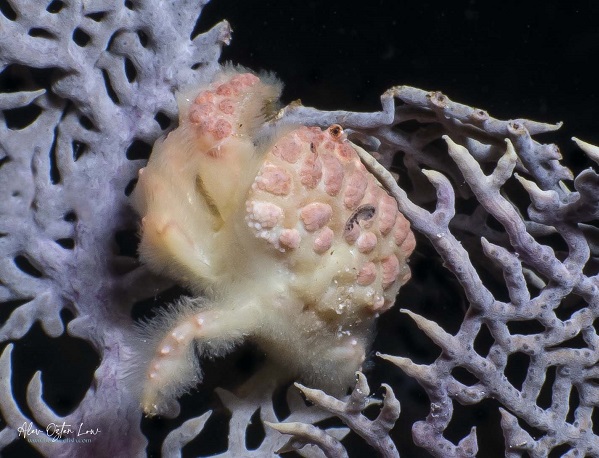

DCNA Nature reports on the recent documentation (in Bonaire) of the previously uncaptured behavior of a hoary rubble crab (Banareia palmeri), who have been seen cutting pieces off coral and carrying them away to their hiding places.
A local diver’s nighttime find is sparking global interest after capturing never before seen crab behavior. During a night dive at Tori’s Reef on Bonaire, local naturalist and photographer Alev Ozten Low captured something no one had ever officially documented before: the tiny hoary rubble crab (Banareia palmeri) was observed cutting off and carrying away the tip of a live coral. This was the second time she had photographed this crab, the first time being 5 years ago at a Northern dive site where two other individuals were observed, one cutting a sea fan and the other a soft coral. This fascinating behavior reveals that this elusive crab might actually be a coral predator living among the reefs of the Dutch Caribbean. Working together with marine biologists from Naturalis Biodiversity Center, this unique crab behavior was recently described in a newly published scientific article, highlighting the value of combining local observations with academic research to uncover new insights into the Dutch Caribbean’s marine life.
A Coral Snipping Specialist
While underwater photographers have long noticed this crab perched on soft corals, this is the first time anyone has documented it actively cutting off pieces of coral. With saw-like claws, the crab snipped off a coral branch several times its size and hauled it down to its hiding place, behavior more commonly seen in some snails and worms, but never before in this species of crab. Older museum specimens confirmed that the crab has the tools for the job: sharp-toothed claws that can cut through the tough, rubbery coral skeleton. The sightings suggest this behavior may be common, but just rarely witnessed due to the crab’s small size and nocturnal habits.
What This Means for Coral Reefs in the Dutch Caribbean
Coral reefs are delicate ecosystems, and understanding every player, especially hidden ones like crabs, is crucial. While the crab is small, its repeated damage to coral tips could influence coral health and growth patterns. It also raises questions about coral regeneration, species interactions, and reef resilience in the face of climate change. These kinds of discoveries highlight the richness and complexity of life in our waters and the importance of monitoring even the most overlooked reef inhabitants. [. . .]
For full article, see https://dcnanature.org/rubblecrab/
[Shown above, photo of a hoary rubble crab by Alev Ozten Low.]
DCNA Nature reports on the recent documentation (in Bonaire) of the previously uncaptured behavior of a hoary rubble crab (Banareia palmeri), who have been seen cutting pieces off coral and carrying them away to their hiding places. A local diver’s nighttime find is sparking global interest after capturing never before seen crab behavior. During a




